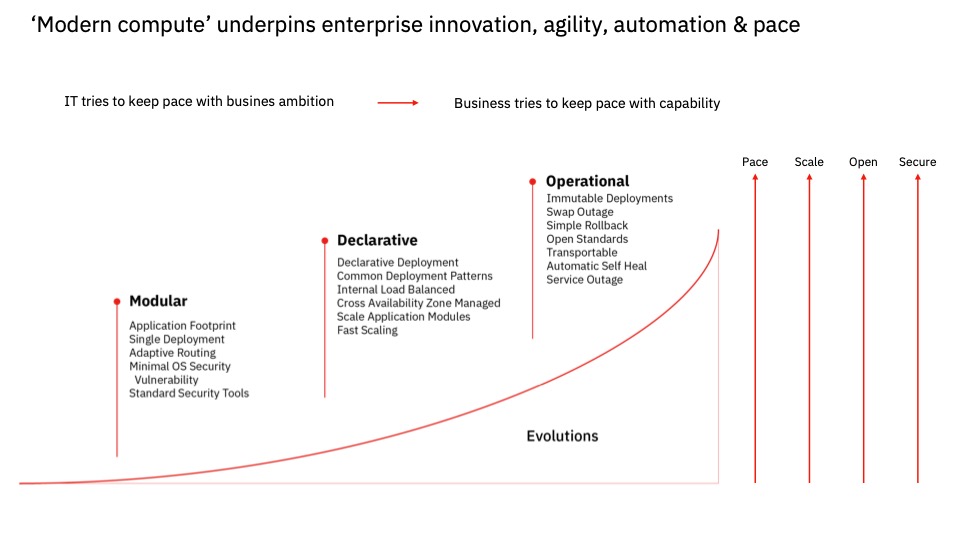About cookies on this site Our websites require some cookies to function properly (required). In addition, other cookies may be used with your consent to analyze site usage, improve the user experience and for advertising. For more information, please review your options. By visiting our website, you agree to our processing of information as described in IBM’sprivacy statement. To provide a smooth navigation, your cookie preferences will be shared across the IBM web domains listed here.
Perspectives
The Era of Modern Compute
23 March, 2021 | Written by: Dan Bailey
Categorized: Perspectives | Topics
Share this post:
The Era of Modern Compute
Are we all missing a trick?
Many IT projects that began more than five years ago have now racked up huge technical debt, with large costs to remediate them. The change projects of yesteryear are now up for renewal and the technical debt costs keep growing.
Meanwhile, individual business units have greater autonomy to make IT decisions that support their goals. The prevalence of cloud has enabled them to move forward with the new – but they have forgotten how to turn off the old. A drawback of empowering business units is that they can go on to create several different standards, which makes it difficult to monitor and keep everything safe under GDPR.
At the same time, the IT industry has a wealth of trends and imperatives around cloud, artificial intelligence, platforms, DevSecOps and other innovations.
Where has this left us as an IT industry?
My observation is that we have had to focus on micro-value such as lift and shift to cloud or things like creating chatbots or building new channels. All great things, but have they forced us back into a siloed approach to value?
So what is the trick we are missing?
There are so many advances in how we do IT that we need to call it something new: Modern Compute perhaps. What does this mean? Well, if you look at the diagram below, we have moved from modular systems through declarative to what could now be called operational systems. Ones that have been hardened before any application has been built.
When I used to build systems in the modular phase I had to build everything from scratch: the “DevOps”, although we didn’t call it that, the automation, the availability scripts, and so on. Now so much of this is hardened into the open community solutions that have been built.
When used correctly, I believe this moves us from an era where the IT couldn’t keep up with the business to an era where the business is going to struggle to keep pace.

When these technologies are harnessed together it is possible to build a strong base of assets, with far better controls than we had in the past. This enables us to continue to grow and do more.
So when you focus on the way we work, modern compute, rather than just executing the next thing then you can build something that continues to grow and enables you to drive much higher levels of value that focuses not just on cost, but also speed, quality, risk and business priority.
The good news is that most of us are already using this modern compute today. But many are just constraining the scope of the value they get from it by not using it at scale, or just looking at smaller problems like lift and shift.
So modern compute is the trick we are missing. There are big rewards to be gained from exploring ways we can exploit it and how we can look at the value statement from a different angle. Check out this paper if you’d like to understand more about how we think this can be done.

Dan Bailey
Chief Technology Officer, GBS, UK&I
More Perspectives stories
By Sharad Somanchi and others on 26 July, 2021
IBM and Adobe: Empowering Creativity
IBM and Adobe: Empowering Creativity Creative leaders and their teams with enterprise-scale content outputs have hit the limits of complexity in creating, managing and optimising their content for a great, personalised customer experience. To empower creative teams to deliver quality at scale and speed, Adobe and IBM have teamed up to bring an end to […]
By Anthony Day on 29 June, 2021
Six steps to solving the sustainability data challenge
Six steps to solving the sustainability data challenge Over the past 18 months, uptake of some of the United Nations sustainable development goals has accelerated, with some very prominent global enterprises making commitments to environmental and social change. The target date cited by these announcements is 2030. That gives businesses less than nine years […]




























